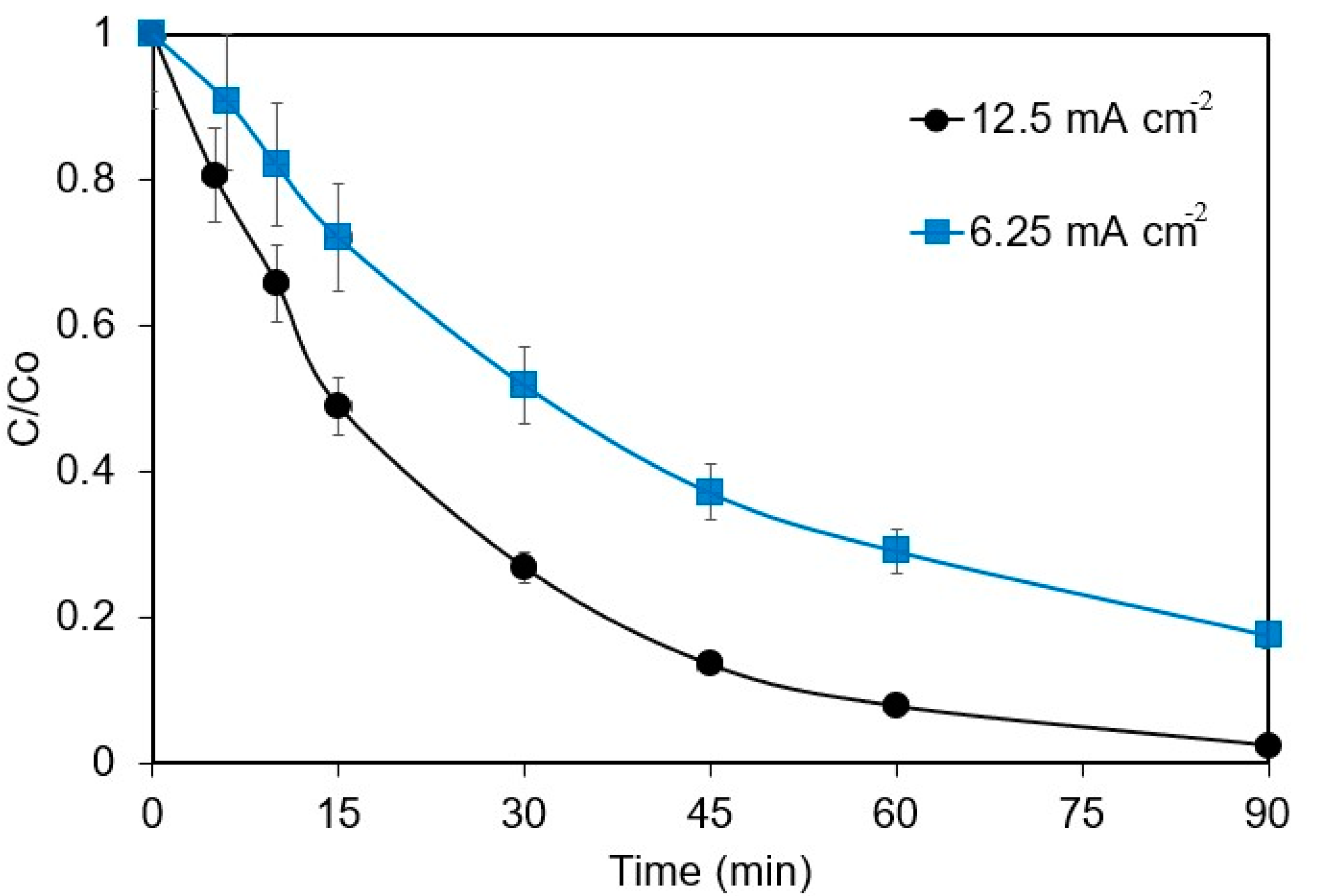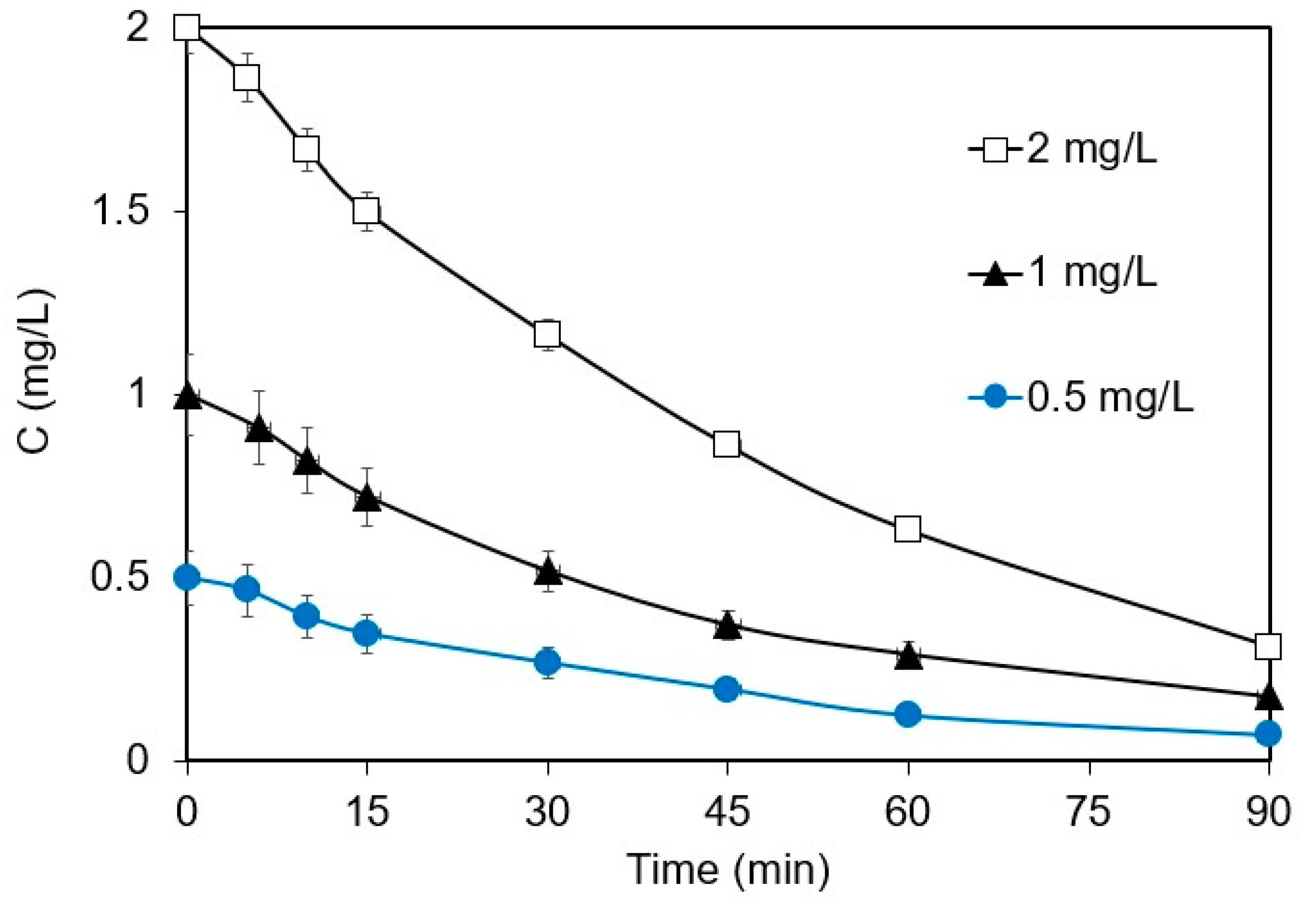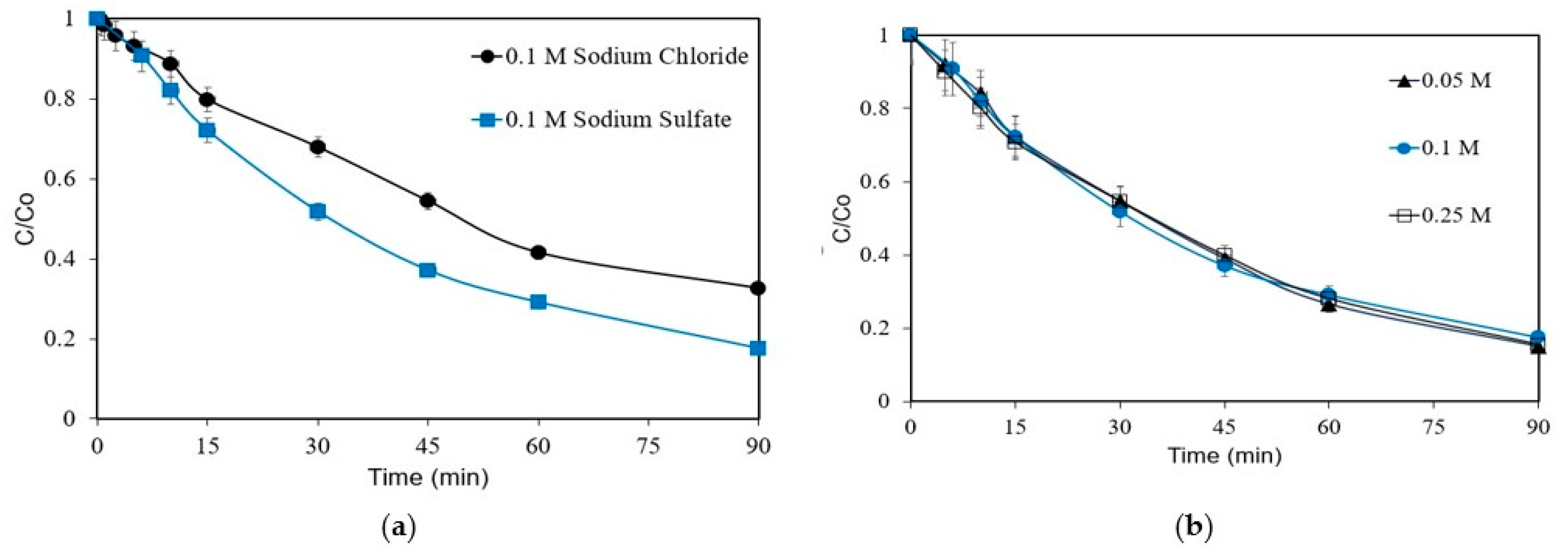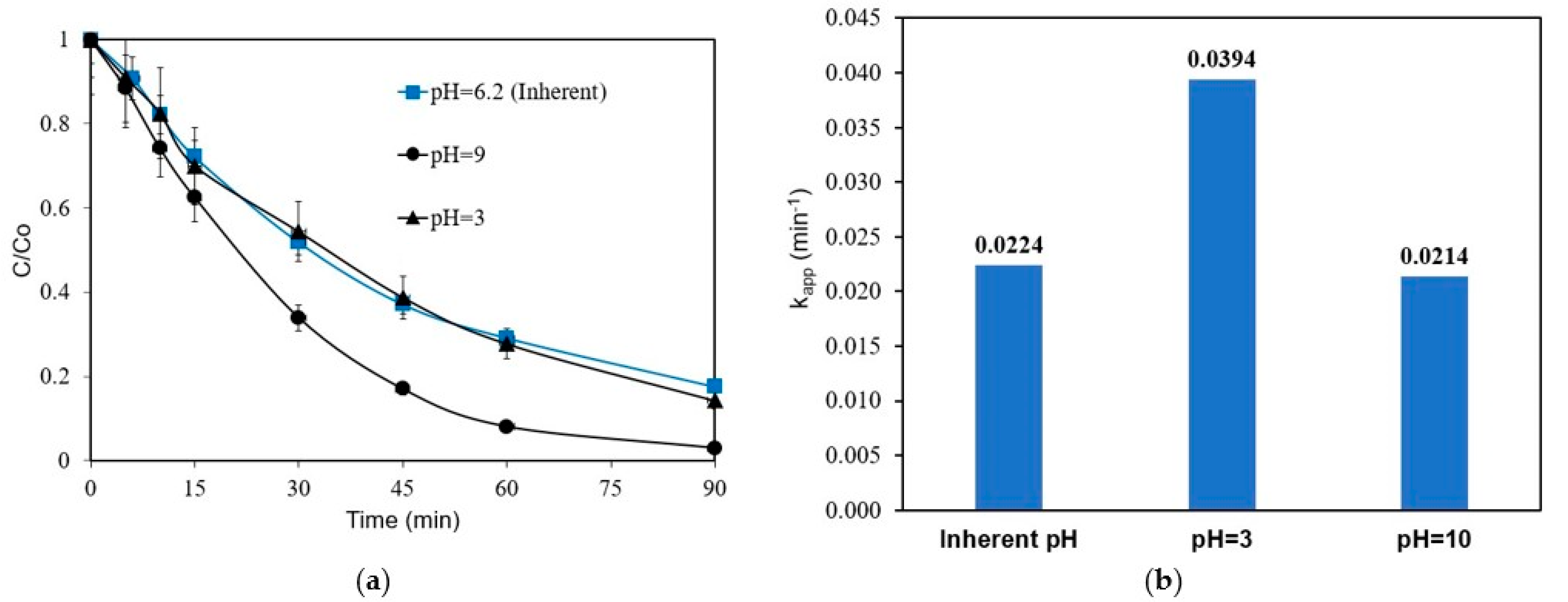Electrochemical Oxidation of Anastrozole over a BDD Electrode: Role of Operating Parameters and Water Matrix
Abstract
:1. Introduction
2. Materials and Methods
2.1. Chemicals
2.2. Experimental Set-Up
2.3. Analytical Methods
3. Results and Discussion
3.1. Effect of Current Density
3.2. Estimation of the Steady State Concentration of Hydroxyl Radicals
3.3. Effect of Initial Concentration
3.4. Effect of Supporting Electrolytes
3.5. Effect of pH
3.6. Effect of the Water Matrix
3.7. Energy Consumption and Cost Analysis
3.8. Electrochemical Oxidation versus Solar Photo-Fenton
4. Conclusions
Supplementary Materials
Author Contributions
Funding
Data Availability Statement
Conflicts of Interest
References
- Bray, F.; Ferlay, J.; Soerjomataram, I.; Siegel, R.L.; Torre, L.A.; Jemal, A. Global cancer statistics 2018: GLOBOCAN estimates of incidence and mortality worldwide for 36 cancers in 185 countries. CA A Cancer J. Clin. 2018, 68, 394–424. [Google Scholar] [CrossRef] [PubMed] [Green Version]
- WHO. Breast Cancer Factsheets; WHO: Geneva, Switzerland, 2021.
- Ghadge, D.; Nangare, S.; Jadhav, N. Formulation, optimization, and in vitro evaluation of anastrozole-loaded nanostructured lipid carriers for improved anticancer activity. J. Drug Deliv. Sci. Technol. 2022, 72, 103354. [Google Scholar] [CrossRef]
- Evaluation of Pharmacokinetics and Safety with Bioequivalence of Anastrozole in Healthy Chinese Volunteers. Clin. Pharmacol. Drug Dev. 2022, 11, 687–694. [CrossRef]
- WHO. World Health Organization Model List of Essential Medicines: 21st list 2019; Technical documents; WHO: Geneva, Switzerland, 2019.
- Lonning, P.; Pfister, C.; Martoni, A.; Zamagni, C. Pharmacokinetics of third-generation aromatase inhibitors. Semin. Oncol. 2003, 30, 23–32. [Google Scholar] [CrossRef]
- ClinCalc DrugStats Database. Clin. Pharmacol. Drug Dev. 2022, 8. Available online: https://clincalc.com/DrugStats/Drugs/Anastrozole (accessed on 23 September 2022).
- Wilkinson, K. Anastrozole (ArimidexR). Home Clin. J. Oncol. Nurs. 2004, 8, 87–88. [Google Scholar] [CrossRef]
- Tousova, Z.; Oswald, P.; Slobodnik, J.; Blaha, L.; Muz, M.; Hu, M.; Brack, W.; Krauss, M.; Di Paolo, C.; Tarcai, Z.; et al. European demonstration program on the effect-based and chemical identification and monitoring of organic pollutants in European surface waters. Sci. Total Environ. 2017, 601–602, 1849–1868. [Google Scholar] [CrossRef]
- Liu, X.; Zhang, J.; Yin, J.; Duan, H.; Wu, Y.; Shao, B. Analysis of hormone antagonists in clinical and municipal wastewater by isotopic dilution liquid chromatography tandem mass spectrometry. Anal. Bioanal. Chem. 2010, 396, 2977–2985. [Google Scholar] [CrossRef]
- Chen, L.; Yang, S.; Zuo, X.; Huang, Y.; Cai, T.; Ding, D. Biochar modification significantly promotes the activity of Co3O4 towards heterogeneous activation of peroxymonosulfate. Chem. Eng. J. 2018, 354, 856–865. [Google Scholar] [CrossRef]
- Oturan, M.A. Outstanding performances of the BDD film anode in electro-Fenton process: Applications and comparative performance. Curr. Opin. Solid State Mater. Sci. 2021, 25, 100925. [Google Scholar] [CrossRef]
- Ganzenko, O.; Trellu, C.; Oturan, N.; Huguenot, D.; Pechaud, Y.; van Hullebusch, E.D.; Oturan, M.A. Electro-Fenton treatment of a complex pharmaceutical mixture: Mineralization efficiency and biodegradability enhancement. Chemosphere 2020, 253, 126659. [Google Scholar] [CrossRef] [PubMed]
- Nidheesh, P.; Zhou, M.; Oturan, M.A. An overview on the removal of synthetic dyes from water by electrochemical advanced oxidation processes. Chemosphere 2018, 197, 210–227. [Google Scholar] [CrossRef] [PubMed]
- Brillas, E.; Martinez-Huitle, C.A. Decontamination of wastewaters containing synthetic organic dyes by electrochemical methods. An updated review. Appl. Catal. B Environ. 2015, 166–167, 603–643. [Google Scholar] [CrossRef]
- Bampos, G.; Petala, A.; Frontistis, Z. Recent Trends in Pharmaceuticals Removal from Water Using Electrochemical Oxidation Processes. Environments 2021, 8, 85. [Google Scholar] [CrossRef]
- Frontistis, Z.; Antonopoulou, M.; Yazirdagi, M.; Kilinc, Z.; Konstantinou, I.; Katsaounis, A.; Mantzavinos, D. Boron-doped diamond electrooxidation of ethyl paraben: The effect of electrolyte on by-products distribution and mechanisms. J. Environ. Manag. 2017, 195, 148–156. [Google Scholar] [CrossRef]
- Peckova, K.; Musilova, J.; Barek, J. Boron-Doped Diamond Film Electrodes—New Tool for Voltammetric Determination of Organic Substances. Crit. Rev. Anal. Chem. 2009, 39, 148–172. [Google Scholar] [CrossRef]
- Pueyo, N.; Ormad, M.P.; Miguel, N.; Kokkinos, P.; Ioannidi, A.; Mantzavinos, D.; Frontistis, Z. Electrochemical oxidation of butyl paraben on boron doped diamond in environmental matrices and comparison with sulfate radical-AOP. J. Environ. Manag. 2020, 269, 110783. [Google Scholar] [CrossRef]
- Sanabria, P.; Scunderlick, D.; Wilde, M.L.; Ludtke, D.S.; Sirtori, C. Solar photo-Fenton treatment of the anti-cancer drug anastrazole in different aqueous matrices at near-neutral pH: Transformation products identification, pathways proposal, and in silico (Q)SAR risk assessment. Sci. Total Environ. 2021, 754, 142300. [Google Scholar] [CrossRef]
- Fotouhi, L.; Hashkavayi, A.B.; Heravi, M.M. Electrochemical behaviour and voltammetric determination of sulphadiazine using a multi-walled carbon nanotube composite film-glassy carbon electrode. J. Exp. Nanosci. 2013, 8, 947–956. [Google Scholar] [CrossRef] [Green Version]
- Feijoo, S.; Kamali, M.; Pham, Q.K.; Assoumani, A.; Lestremau, F.; Cabooter, D.; Dewil, R. Electrochemical Advanced Oxidation of Carbamazepine: Mechanism and optimal operating conditions. Chem. Eng. J. 2022, 446, 137114. [Google Scholar] [CrossRef]
- Lebik-Elhadi, H.; Frontistis, Z.; Ait-Amar, H.; Amrani, S.; Mantzavinos, D. Electrochemical oxidation of pesticide thiamethoxam on boron doped diamond anode: Role of operating parameters and matrix effect. Process Saf. Environ. Prot. 2018, 116, 535–541. [Google Scholar] [CrossRef]
- Frontistis, Z.; Mantzavinos, D.; Meric, S. Degradation of antibiotic ampicillin on boron-doped diamond anode using the combined electrochemical oxidation—Sodium persulfate process. J. Environ. Manag. 2018, 223, 878–887. [Google Scholar] [CrossRef] [PubMed]
- Kaur, R.; Kushwaha, J.P.; Singh, N. Amoxicillin electro-catalytic oxidation using Ti/RuO2 anode: Mechanism, oxidation products and degradation pathway. Electrochim. Acta 2019, 296, 856–866. [Google Scholar] [CrossRef]
- De Luna, Y.; Bensalah, N. Review on the electrochemical oxidation of endocrine-disrupting chemicals using BDD anodes. Curr. Opin. Electrochem. 2022, 32, 100900. [Google Scholar] [CrossRef]
- Marselli, B.; Garcia-Gomez, J.; Michaud, P.-A.; Rodrigo, M.A.; Comninellis, C. Electrogeneration of Hydroxyl Radicals on Boron-Doped Diamond Electrodes. J. Electrochem. Soc. 2003, 150, D79. [Google Scholar] [CrossRef]
- Arvaniti, O.S.; Konstantinou, I.; Mantzavinos, D.; Frontistis, Z. Destruction of valsartan using electrochemical and electrochemical/persulfate process. Kinetics, identification of degradation pathway and application in aqueous matrices. J. Environ. Chem. Eng. 2021, 9, 106265. [Google Scholar] [CrossRef]
- Periyasamy, S.; Lin, X.; Ganiyu, S.O.; Kamaraj, S.K.; Thiam, A.; Liu, D. Insight into BDD electrochemical oxidation of florfenicol in water: Kinetics, reaction mechanism, and toxicity. Chemosphere 2022, 288, 132433. [Google Scholar] [CrossRef] [PubMed]
- Cai, J.; Zhou, M.; Pan, Y.; Lu, X. Degradation of 2,4-dichlorophenoxyacetic acid by anodic oxidation and electro-Fenton using BDD anode: Influencing factors and mechanism. Sep. Purif. Technol. 2020, 230, 115867. [Google Scholar] [CrossRef]
- Tang, Y.; He, D.; Guo, Y.; Qu, W.; Shang, J.; Zhou, L.; Pan, R.; Dong, W. Electrochemical oxidative degradation of X-6G dye by boron-doped diamond anodes: Effect of operating parameters. Chemosphere 2020, 258, 127368. [Google Scholar] [CrossRef]
- Frontistis, Z.; Meric, S. The role of operating parameters and irradiation on the electrochemical degradation of tetracycline on boron doped diamond anode in environmentally relevant matrice. J. Chem. Technol. Biotechnol. 2018, 93, 3648–3655. [Google Scholar] [CrossRef]
- El-Ghenymy, A.; Arias, C.; Cabot, P.L.; Centellas, F.; Garrido, J.A.; Rodriguez, R.M.; Brillas, E. Electrochemical incineration of sulfanilic acid at a boron-doped diamond anode. Chemosphere 2012, 87, 1126–1133. [Google Scholar] [CrossRef]
- Pereira, G.F.; Rocha-Filho, R.C.; Bocchi, N.; Biaggio, S.R. Electrochemical degradation of bisphenol A using a flow reactor with a boron-doped diamond anode. Chem. Eng. J. 2012, 198–199, 282–288. [Google Scholar] [CrossRef]
- Ning, Y.; Li, K.; Zhao, Z.; Chen, D.; Li, Y.; Liu, Y.; Yang, Q.; Jiang, B. Simultaneous electrochemical degradation of organophosphorus pesticides and recovery of phosphorus: Synergistic effect of anodic oxidation and cathodic precipitation. J. Taiwan Inst. Chem. Eng. 2021, 125, 267–275. [Google Scholar] [CrossRef]
- Grilla, E.; Taheri, M.E.; Miserli, K.; Venieri, D.; Konstantinou, I.; Mantzavinos, D. Degradation of dexamethasone in water using BDD anodic oxidation and persulfate: Reaction kinetics and pathways. J. Chem. Technol. Biotechnol. 2021, 196, 2451–2460. [Google Scholar] [CrossRef]
- Giannakopoulos, S.; Kokkinos, P.; Hasa, B.; Frontistis, Z.; Katsaounis, A.; Mantzavinos, D. Electrochemical Oxidation of Pharmaceuticals on a Pt–SnO2/Ti Electrode. Electrocatalysis 2022, 13, 363–377. [Google Scholar] [CrossRef]
- Nashat, M.; Mossad, M.; El-Etriby, H.K.; Gar Alalm, M. Optimization of electrochemical activation of persulfate by BDD electrodes for rapid removal of sulfamethazine. Chemosphere 2022, 286, 131579. [Google Scholar] [CrossRef]
- Bu, L.; Zhu, S.; Zhou, S. Degradation of atrazine by electrochemically activated persulfate using BDD anode: Role of radical and influencing factors. Chemosphere 2018, 195, 236–244. [Google Scholar] [CrossRef] [PubMed]
- Ding, J.; Bu, L.; Zhao, Q.; Kabutey, F.T.; Wei, L.; Dionysiou, D.D. Electrochemical activation of persulfate on BDD and DSA anodes: Electrolyte influence, kinetics and mechanisms in the degradation of bisphenol A. J. Hazard. Mater. 2020, 388, 121789. [Google Scholar] [CrossRef]
- Bolton, J.R.; Bircher, K.G.; Tumas, W.; Tolman, C.A. Figures-of-merit for the technical development and application of advanced oxidation technologies for both electric- and solar-driven systems (IUPAC Technical Report). Pure Appl. Chem. 2001, 73, 627–637. [Google Scholar] [CrossRef]
- Eurostat. Electricity Price Statistics; Eurostat Statistics Explained; Eurostat: Luxemburg, 2022.





| PARAMETERS | DESCRIPTION |
|---|---|
| COMMERCIAL NAME | Anastrozole |
| IUPAC NAME | 2,2′-[5-(1H-1,2,4-triazol-1-ylmethyl)-1,3-phenylene]bis(2-methylpropanenitrile) |
| MOLECULAR FORMULA | C17H19N5 |
| DRUG CLASS | Aromatase Inhibitor |
| STRUCTURE |  |
| MOLECULAR MASS | 293.374 g mol-1 |
| CAS NUMBER | 120511-73-1 |
| APPLICATION | Treatment of Breast Cancer |
| Water Matrix: | Bottled Water (BW) | Wastewater (WW) |
|---|---|---|
| Contents | Concentration (mg L−1) | Concentration (mg L−1) |
| HCO3− | 273.9 | 278 |
| Cl− | 3.8 | 262 |
| NO2− | 0 | n.d |
| SO4− | 7.9 | 0 |
| NO3− | 1 | n.d |
| PO4− | n.d | 14.9 |
| F− | 0.07 | 0 |
| Ca2+ | 75.5 | 112 |
| Mg2+ | 5.1 | n.d |
| Na+ | 2.1 | n.d |
| K+ | 0.6 | n.d |
| TDS | 254 | n.d |
| TSS | n.d | 22 |
| TOC | <1 | 2.5 |
| COD | n.d | 48.5 |
Publisher’s Note: MDPI stays neutral with regard to jurisdictional claims in published maps and institutional affiliations. |
© 2022 by the authors. Licensee MDPI, Basel, Switzerland. This article is an open access article distributed under the terms and conditions of the Creative Commons Attribution (CC BY) license (https://creativecommons.org/licenses/by/4.0/).
Share and Cite
Dhawle, R.; Frontistis, Z.; Mantzavinos, D. Electrochemical Oxidation of Anastrozole over a BDD Electrode: Role of Operating Parameters and Water Matrix. Processes 2022, 10, 2391. https://doi.org/10.3390/pr10112391
Dhawle R, Frontistis Z, Mantzavinos D. Electrochemical Oxidation of Anastrozole over a BDD Electrode: Role of Operating Parameters and Water Matrix. Processes. 2022; 10(11):2391. https://doi.org/10.3390/pr10112391
Chicago/Turabian StyleDhawle, Rebecca, Zacharias Frontistis, and Dionissios Mantzavinos. 2022. "Electrochemical Oxidation of Anastrozole over a BDD Electrode: Role of Operating Parameters and Water Matrix" Processes 10, no. 11: 2391. https://doi.org/10.3390/pr10112391
APA StyleDhawle, R., Frontistis, Z., & Mantzavinos, D. (2022). Electrochemical Oxidation of Anastrozole over a BDD Electrode: Role of Operating Parameters and Water Matrix. Processes, 10(11), 2391. https://doi.org/10.3390/pr10112391








